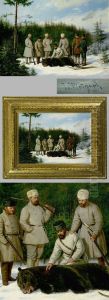Ludwig Pietsch Paintings
Ludwig Pietsch was a German journalist, art critic, and novelist born on February 14, 1824, in Landeshut, Silesia (now Kamienna Góra, Poland). His contributions to the world of art and literature spanned the better part of the 19th century, during which he became known for his close associations with many of the leading literary and artistic figures of his time, including a notable friendship with the famous poet and playwright, Heinrich Heine.
Pietsch's early career was marked by his involvement in journalism. He moved to Berlin in the 1840s, where he initially worked as a teacher before fully immersing himself in the vibrant journalistic scene. He contributed to various newspapers and magazines, where his art critiques and cultural commentaries gained him recognition. His insightful analyses and eloquent writing style established him as a respected voice in the arts community.
Throughout his career, Pietsch was deeply involved in the German art scene, particularly with the artists associated with the Berlin Secession, a movement that sought to break away from the traditional academic style of art that dominated the era. He was known for his progressive views on art and was an advocate for the Impressionist movement, which was gaining popularity in France. Despite his initial skepticism towards the Impressionists, he later became one of their supporters, recognizing the movement's significance and its contribution to modern art.
Beyond his work as a critic, Pietsch was also a prolific writer. He authored several novels and biographies, including a notable biography of Heinrich Heine, which further cemented his reputation as a distinguished literary figure. His writings not only reflect his deep understanding of art and culture but also provide valuable insights into the social and political milieu of 19th-century Germany.
Ludwig Pietsch's legacy is that of a pioneering critic and writer who played a crucial role in shaping the discourse around art and literature in his time. He passed away on September 2, 1911, in Berlin, leaving behind a body of work that continues to be studied for its impact on German art criticism and literature.




